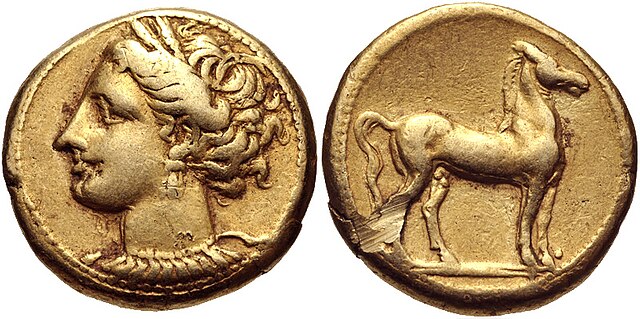Carthaginian or Punic currency refers to the coins of ancient Carthage, a Phoenician city-state located near present-day Tunis, Tunisia. Between the late fifth century BC and its destruction in 146 BC, Carthage produced a wide range of coinage in gold, electrum, silver, billon, and bronze. The base denomination was the shekel, probably pronounced in Punic. Only a minority of Carthaginian coinage was produced or used in North Africa. Instead, the majority derive from Carthage's holdings in Sardinia and western Sicily.
An incense burner depicting Ba'al-Hamon, 2nd century BC
Jenkins-Lewis, Group III (ca. 350-320 BC): electrum shekel. Obverse: wreathed female head. Reverse: Standing horse.
Jenkins-Lewis, Group III (ca. 350-320 BC): electrum shekel. Obverse: wreathed female head. Reverse: Standing horse.
Silver tetradrachm of Alexander the Great, minted at Amphipolis. The obverse depiction of Heracles is the model for the obverse of Carthage's Series V silver tetradrachms.
Shekel or sheqel is an ancient Mesopotamian coin, usually of silver. A shekel was first a unit of weight—very roughly 11 grams —and became currency in ancient Tyre and Carthage and then in Hasmonean Judea.
An electrum Carthaginian shekel, c. 310–290 BC, bearing the image of Tanit, consort of Baal Hammon
Shekel from the First Jewish–Roman War with the legend לגאלת ציון, "To the redemption of Zion", in Paleo-Hebrew script, at the Rockefeller Archeological Museum





